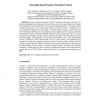173 search results - page 20 / 35 » Learning to rank networked entities |
IJCNN
2006
IEEE
14 years 1 months ago
2006
IEEE
—We present a structured model of context that supports an integrated approach to language acquisition and use. The model extends an existing formal notation, Embodied Constructi...
WSDM
2009
ACM
14 years 2 months ago
2009
ACM
Recently the re-ranking algorithms have been quite popular for web search and data mining. However, one of the issues is that those algorithms treat the content and link informati...
MLDM
2007
Springer
14 years 1 months ago
2007
Springer
Recursive Feature Elimination (RFE) combined with feature ranking is an effective technique for eliminating irrelevant features when the feature dimension is large, but it is diffi...
ICDAR
2003
IEEE
14 years 27 days ago
2003
IEEE
In this paper, we propose a novel method of building a language model for open-vocabulary Korean word recognition. Due to the complex morphology of Korean, it is inappropriate to ...
JAIR
2007
13 years 7 months ago
2007
Previous work in social network analysis (SNA) has modeled the existence of links from one entity to another, but not the attributes such as language content or topics on those li...

